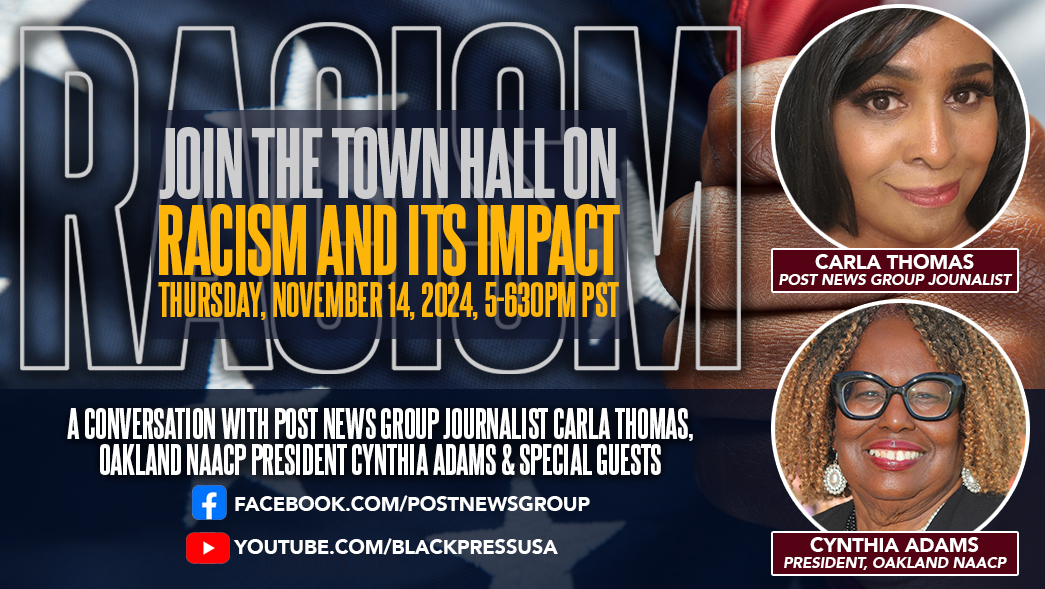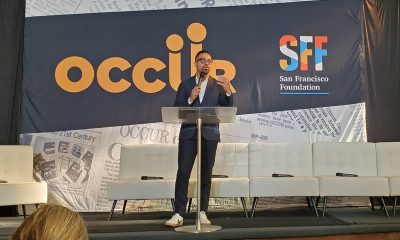Environment
Keep Hayward Clean & Green
The Keep Hayward Clean & Green Task Force will hold its final community cleanup event of the year on Saturday, Nov. 22 at Hayward High School, 1633 East Ave.
This is a great opportunity to do something positive for your neighborhood. The litter and graffiti cleanup event is part of the citywide high school challenge. Participating Hayward High School students can enter their name in a drawing for a chance to win a gift card. Participants may also qualify for community service hours.
The KHCG community cleanup event will begin at 8:30 a.m. Participants will fan out across the East Avenue and Upper B Street neighborhoods to clean up and beautify the area. Grab your gloves and a pair of comfortable shoes; it’s time to help clean up Hayward!
For more information, contact Suzanne Gayle at (510) 581-2787 or visit www.hayward-ca.gov/khcg.
California Black Media
Gov. Newsom Goes to Washington to Advocate for California Priorities
Gov. Gavin Newsom traveled to Washington, D.C., for meetings with senior Biden-Harris Administration officials and members of California’s congressional delegation. During the week, he pushed for increased resources to improve public safety and quality of life in California.

By Bo Tefu, California Black Media
Gov. Gavin Newsom traveled to Washington, D.C., for meetings with senior Biden-Harris Administration officials and members of California’s congressional delegation.
During the week, he pushed for increased resources to improve public safety and quality of life in California.
“California is continuing our work to secure additional tools and resources to improve access to health care, clean air and water, and secure critical funding to support communities recovering from disasters,” said Newsom.
At the White House, Newsom met with President Joe Biden and key officials, advocating for disaster relief funding, healthcare expansion, and environmental protection. He also engaged in discussions with senior Biden-Harris officials, including Interior Secretary Deb Haaland, to address water quality improvements and the San Luis Dam project, which will support water supplies for two million Californians.
“Building on our strong partnership with the Biden-Harris Administration, California is working closely with the White House over the next two months to deliver the critical protections and resources our communities need,” Newsom said.
On Capitol Hill, Newsom met with California Senators Alex Padilla and Adam Schiff, along with other Congressional leaders, to emphasize the need to approve pending disaster funding, healthcare programs, and environmental protections. He also previewed California’s upcoming special session to proactively address potential federal challenges when President-elect Donald Trump is sworn into office.
Newsom’s discussions also focused on securing Medicaid waivers from the Center for Medicare & Medicaid Services (CMS) to enhance behavioral health services and reduce homelessness. The state seeks approval for the BH-CONNECT waiver, which would address behavioral health and homelessness, and the MCO Tax Waiver, which would provide over $20 billion for Medi-Cal to improve healthcare access.
Additionally, California is pushing for Clean Air Act waivers from the U.S. Environmental Protection Agency (EPA), which are crucial for enforcing air quality regulations. These measures are projected to prevent 11,000 premature deaths and provide $116 billion in health benefits over the next three decades, according to the Governor’s office.
Activism
LIVE! — TOWN HALL ON RACISM AND ITS IMPACT — THURS. 11.14.24 5PM PST
Join us for a LIVE Virtual Town Hall on the Impact of Racism hosted by Post News Group Journalist Carla Thomas and featuring Oakland, CA NAACP President Cynthia Adams & other Special Guests.
Thursday, November 14, 2024, 5 p.m. – 6:30 p.m. PST


Join us for a LIVE Virtual Town Hall on the Impact of Racism hosted by Post News Group Journalist Carla Thomas and featuring Oakland, CA NAACP President Cynthia Adams & other Special Guests.
Thursday, November 14, 2024
5 p.m. – 6:30 p.m. PST
Discussion Topics:
• Since the pandemic, what battles have the NAACP fought nationally, and how have they impacted us locally?
• What trends are you seeing concerning Racism? Is it more covert or overt?
• What are the top 5 issues resulting from racism in our communities?
• How do racial and other types of discrimination impact local communities?
• What are the most effective ways our community can combat racism and hate?
Your questions and comments will be shared LIVE with the moderators and viewers during the broadcast.
STREAMED LIVE!
FACEBOOK: facebook.com/PostNewsGroup
YOUTUBE: youtube.com/blackpressusatv
X: twitter.com/blackpressusa
Business
Gov. Newsom Issues Executive Order to Tackle Rising Electric Bills
Gov. Gavin Newsom has issued an executive order to help alleviate the financial burden of skyrocketing electric bills on residents. This directive instructs the state’s Public Utilities Commission (PUC) and Energy Commission to identify strategies to lower electricity costs and prevent rapid increases in the future.

By Bo Tefu, California Black Media
Gov. Gavin Newsom has issued an executive order to help alleviate the financial burden of skyrocketing electric bills on residents. This directive instructs the state’s Public Utilities Commission (PUC) and Energy Commission to identify strategies to lower electricity costs and prevent rapid increases in the future.
Among the key actions proposed, the governor emphasized a closer examination of utility expenditures related to wildfire mitigation, which accounts for about 13% of residential electric bills.
Newsom underscored the state’s commitment to balancing affordability with environmental goals.
“We’re taking action to address rising electricity costs and save consumers money on their bills,” said Newsom. “California is proving that we can address affordability concerns as we continue our world-leading efforts to combat the climate crisis.”
California now has the second-highest electric rates in the country, trailing only Hawaii, with residential bills having surged as much as 110% over the past decade. The largest utilities, including Pacific Gas & Electric, Southern California Edison, and San Diego Gas & Electric, have seen rate hikes of 20% to 50% in just the last three years, approved by the state’s regulatory bodies.
The executive order also directs the California Air Resources Board (CARB) to explore increasing the California Climate Credit, which provides some relief on energy costs for residents. Additionally, the PUC is urged to pursue federal funding opportunities to further reduce electric expenses.
While consumer advocates welcomed the governor’s focus on lowering costs, concerns were raised regarding potential cuts to essential clean energy programs. CALPIRG, a consumer group, pointed out that the real issue behind high utility bills is wasteful spending by utilities and urged greater accountability.
-

 California Black Media4 weeks ago
California Black Media4 weeks agoCalifornia to Offer $43.7 Million in Federal Grants to Combat Hate Crimes
-

 Black History4 weeks ago
Black History4 weeks agoEmeline King: A Trailblazer in the Automotive Industry
-

 California Black Media4 weeks ago
California Black Media4 weeks agoGov. Newsom Goes to Washington to Advocate for California Priorities
-

 California Black Media4 weeks ago
California Black Media4 weeks agoCalifornia Department of Aging Offers Free Resources for Family Caregivers in November
-

 Activism3 weeks ago
Activism3 weeks agoOakland Post: Week of November 27 – December 3, 2024
-

 Activism4 weeks ago
Activism4 weeks agoOCCUR Hosts “Faith Forward” Conference in Oakland
-

 Activism4 weeks ago
Activism4 weeks agoRichmond Seniors Still Having a Ball After 25 Years
-

 Activism2 weeks ago
Activism2 weeks agoButler, Lee Celebrate Passage of Bill to Honor Congresswoman Shirley Chisholm with Congressional Gold Medal

























































